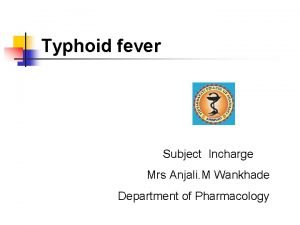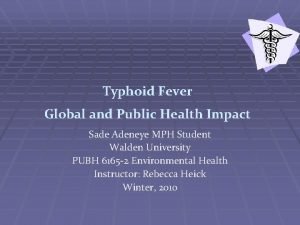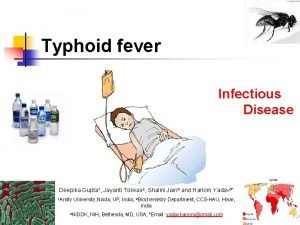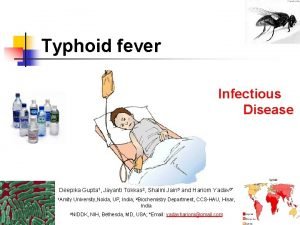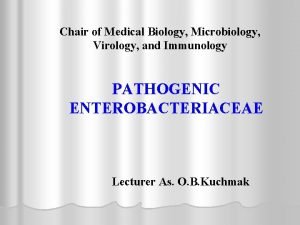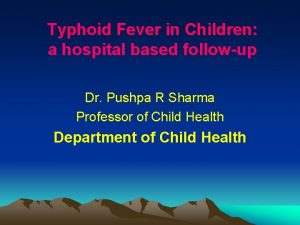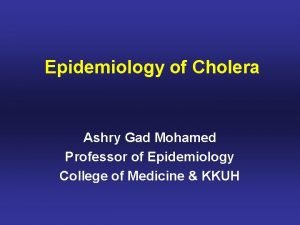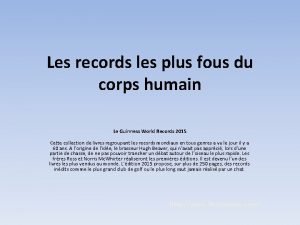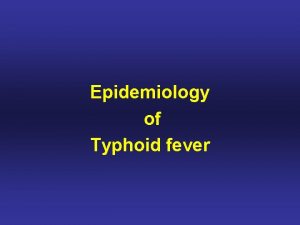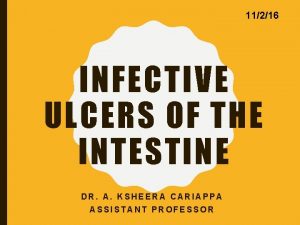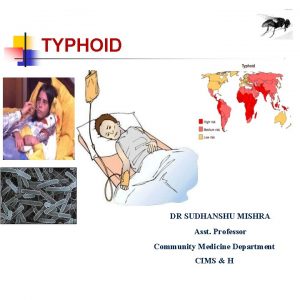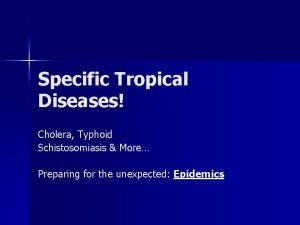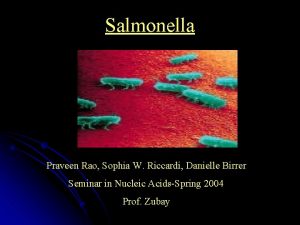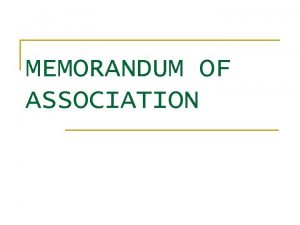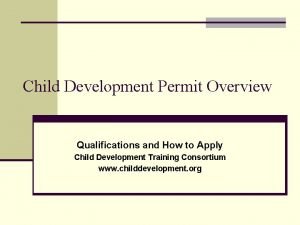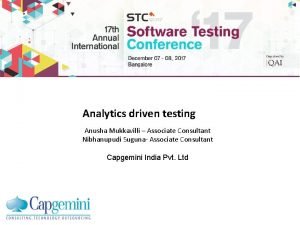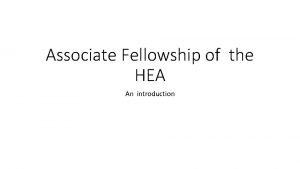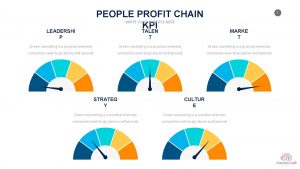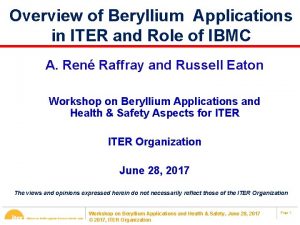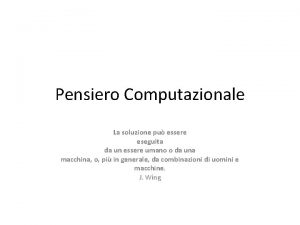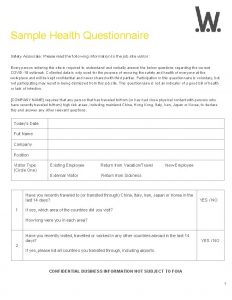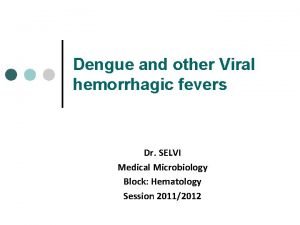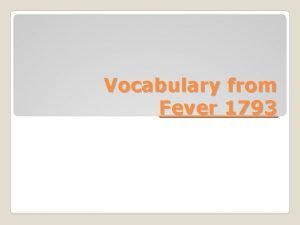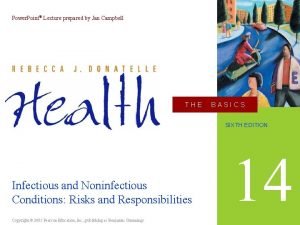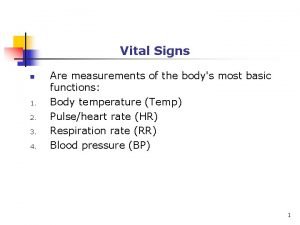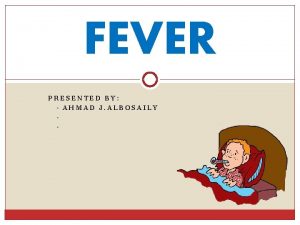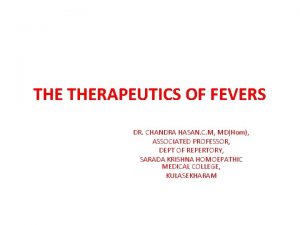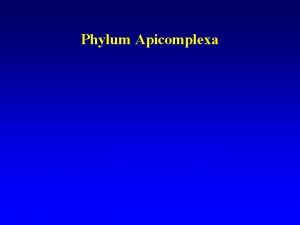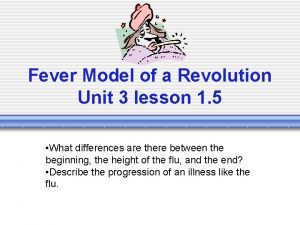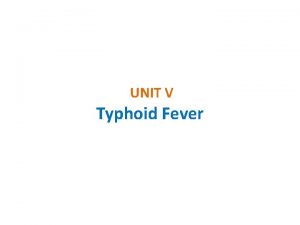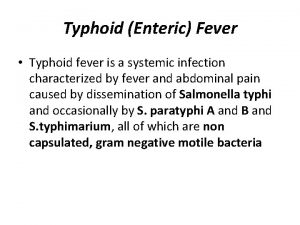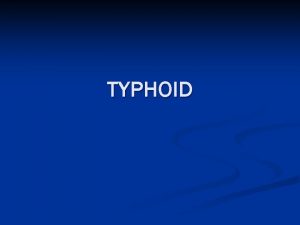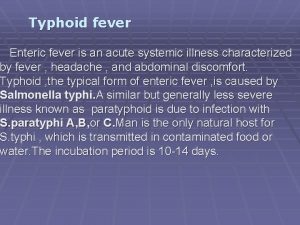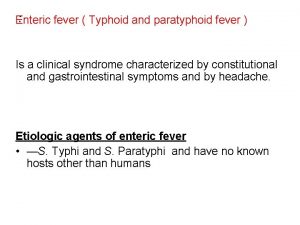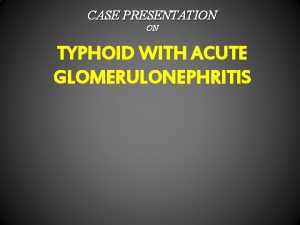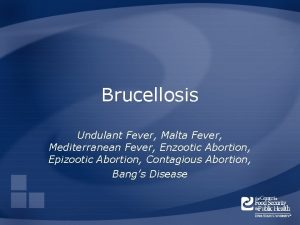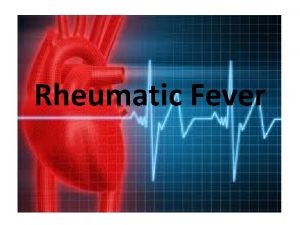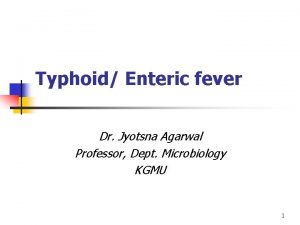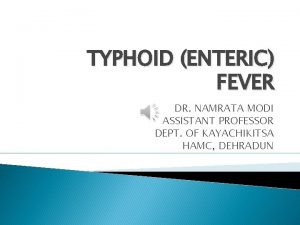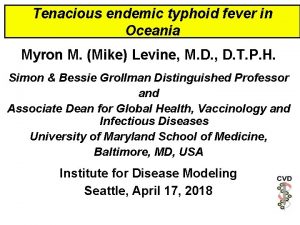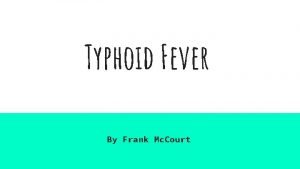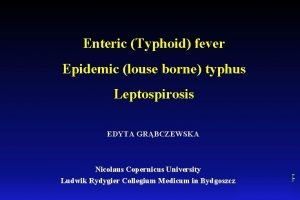Typhoid Fever Dr Grishma Chauhan Associate Professor Community








































































- Slides: 72

Typhoid Fever Dr. Grishma Chauhan, Associate Professor, Community Medicine dept.

TYPHOID FEVER � Typhoid fever is the result of systemic infection mainly by S. typhi found only in man. � It is an acute generalized infection of the reticulo endothelial system, intestinal lymphoid tissue, and the gall bladder. � The disease is clinically characterized by a typical continuous fever for 3 to 4 weeks, relative bradycardia with involvement of lymphoid tissues and considerable constitutional symptoms. � The term "enteric fever" includes both typhoid and paratyphoid fevers. � May occur sporadically, epidemically or endemically. Found only in human.

Typhoid fever is prevalent in many regions in the world High endemicity (>100 cases per lac per year) Medium endemicity (10 cases per lac per year) Low endemicity (<10 cases per lac per year)

EPIDEMIOLOGY

WHO Estimate Infects roughly 21. 6 million people each year

WHO Estimate Kills 21600000 people each year

WHO Estimate 62% of these occurring in Asia and 35% in Africa

• Antibiotic resistance is a challenge for effective treatment of typhoid and is likely to become increasingly problematic with the spread of multi-drug resistant strains. • The situation is further complicated by increased incidence in some countries of S. Paratyphi A as a cause of enteric fever. • This serovar is not prevented by currently available typhoid vaccines and represents an increasing threat to human health.

India � World largest outbreak of typhoid in SANGLI between December 1975 to February 1976. � This disease is endemic in India � 1992 : 3, 52, 980 cases with 735 deaths � 1993 : 3, 57, 452 cases and 888 deaths � 1994 : 2, 78, 451 cases and 304 deaths � 2011 : 1. 06 million cases & 346 deaths � Prevalence- 88 cases/lac population � Case fatality rate due to typhoid has been varying between 1. 1% to 2. 5 % in last few years. � In south-East Asia 50% or more of the strains of bacteria has MDR

cont. . � Reported data for the year 2015 shows 1. 84 million cases and 393 deaths per 1 lac population � Maximum cases were reported from Bihar followed by Andhra Pradesh. � The other states having large number of cases are, Uttar Pradesh, Madhya Pradesh, West Bengal, Maharashtra, Odissa.

AGENT FACTORS � Typhoid Fever mainly caused by the bacterium Salmonella typhi from the family Enterobacteriacea. � S. Para A& B are relatively infrequent. � S. typhi is a gram-negative, facultative aerobic, non spore forming bacteria that is motile due to its peritrichous flagella. � The bacteria grows best at 37°C. � S. typhi survives intracellularly in the tissues of various organs. It is readily killed by drying, pasteurization, and common disinfectants.

Antigenic structure of Salmonella Two sets of antigens Detection by serotyping 1. Somatic or 0 Antigens contain long chain polysaccharides ( LPS ) comprises of heat stable polysaccharide commonly. 2. Flagellar or H Antigens are strongly immunogenic and induces antibody formation rapidly and in high titers following infection or immunization. The flagellar antigen is of a dual nature, occurring in one of the two phases. � Phage typing has proved a useful epidemiological tool in tracing the source of epidemics.

Color pink therefore Gram-negative With peritrichous flagella



Reservoir of infection Human is the only reservoir CASE 1. Cases � A case is infectious as long as bacilli appears in stools or urine. � Case may be missed, mild or severe. CARRIER 2. Carriers � Temporary/Incubatoryexcrete bacilli for 6 to 8 weeks � Chronic- excrete bacilli for more than a year, Organism persist in gall bladder/biliary tract. e. g. “Typhoid Marry” real name Mary Mallon

� Mary Mallon was a cook in Oyster Bay, New York in early 1900 s. � Gave rise to more than 1300 cases in her life time. � She died of pneumonia after 26 years in quarantine.


Source of infection � Faeces & urine of cases and carriers. � Faecal carriers are more frequent than urinary carriers. Primary sources � Contaminated �Water �Food �Fingers �Flies Secondary sources • There is no evidence that typhoid bacilli are excreted in sputum or milk. • Period of communicability: A case is infectious as long as the bacilli appear in stool or urine.

How does the bacteria cause disease ?

Ingestion of contaminated food or water Salmonella bacteria Invade small intestine and enter the bloodstream Carried by white blood cells in the liver, spleen, and bone marrow Multiply and reenter the bloodstream Bacteria invade the gallbladder, biliary system, and the lymphatic tissue of the bowel and multiply in high numbers Then pass into the intestinal tract and can be identified for diagnosis in cultures from the stool tested in the laboratory

Salmonella typhi infecting the body via the Peyer's patches of the small intestine. The bacteria migrates to mesenteric lymph nodes and arrive via the blood in the liver and spleen during the first exposure. After multiple replication in the above locations, the bacteria Migrates back into the Peyer's patches of the small intestine for the secondary exposure and consequently the clinical symptoms are seen. Inflammation in the small intestine leads to ulcers and necrosis.

HOST FACTORS � Age: Typhoid fever may occur at any age. Highest incidence of this disease occurs in the 5 -19 years of age group. In a recent study from slums of Delhi, it was found that contrary to popular belief, the disease affects even children aged 1 -5 years � Sex: More cases are reported among males than females, probably as a result of increased exposure to infection. But carrier rate is more in females. � Occupation : Certain categories of persons handling the infective material and live cultures of S. typhi are at increased risk of acquiring infection.

Cont. . � Nutritional status : Malnutrition may enhance the susceptibility to typhoid fever by altering the intestinal flora or other host defences. � Immunity: All ages are susceptible to infection. Antibody may be stimulated by the infection or by immunization. However, the antibody to the somatic antigen (0) is usually higher in the patient with the disease, and the antibody to the flagellar antigen (H) is usually higher in immunized individuals. � Cell-mediated immunity plays a major role in combating the infection

ENVIRONMENTAL & SOCIAL FACTORS Typhoid fever regarded as “Index of general sanitation” in any country. It is a disease of Poverty. . q Increase incidence in July-September. q Outside human body bacilli found inwater- 2 to 7 days but not multiply soil irrigated with sewage- 35 to 70 days ice & icecream- over a month food- multiply & survive for sometime milk- grow rapidly without altering its taste q Vegetables grow in sewage plant. q Pollution of drinking water supplies. q Open area defecation & urination. q Low personal hygiene. q Health ignorance. q

Incubation period � Usually 10 -14 days. But it may be as short as 3 days or as long as three weeks depending upon the dose of the bacilli ingested.

MODE OF TRANSMISSION The disease is transmitted by “faeco-oral route” or “urine–oral routes” either directly through hands soiled with faeces or urine of cases or carriers or indirectly by ingestion of contaminated water, milk, food, or through flies. Contaminated ice, ice-creams, and milk products are a rich source of infection. water Faeces and urine from cases or carriers soil flies fingers Foods raw or cooked Mouth of well persons

Cont. . The situation is rendered more complex by the web of social, cultural and economic factors which determine the quality of life of the people.

Clinical Features � The onset is usually insidious but in children may be abrupt, with chills and high fever. � During the Prodromal stage, there is malaise, headache, cough and sore throat, often with abdominal pain and constipation. � The fever ascends in a Step ladder fashion. After about 7 -10 days, the fever reaches a plateau and the patient looks toxic, appearing exhausted and often prostrated. � There may be marked constipation, especially in early stage or "pea soup" diarrhoea. There is marked abdominal distention.

� First week: � Second week: The disease classically presents with step-ladder fashion rise in temperature (40 - 41°C) over 4 to 5 days, accompanied by headache, vague abdominal pain, and constipation. Between the 7 th -10 th day of illness, mild hepatosplenomegally occurs in majority of patients. Relative bradycardia may occur and rose-spots may be seen. � Third week: The patient will appear in the "typhoid state" which is a state of prolonged apathy, toxaemia, delirium, disorientation and/or coma. Diarrhoea will then become apparent. If left untreated by this time, there is a high risk (5 -10%) of intestinal hemorrhage and perforation. � Rare complications: Hepatitis, Pneumonia, Thrombophlebitis, Myocarditis, Cholecystitis, Nephritis, Osteomyelitis, and Psychosis. 2 -5% patients may become Gall-bladder carriers


Rose spots Pink papule 2 -3 mm on trunk, fade on pressure Disappears in 3 -4 days

DIAGNOSIS

� Typhoid should be considered in any patient with prolonged unexplained fever in endemic areas and in those with a history of recent travel to endemic area. � Prolonged fever, rose spots, relative bradycardia and leucopenia make typhoid strongly suggestive. � Widal test measures titres of serum agglutinins against somatic (O) and flagellar (H) antigens which usually begin to appear during the 2 nd week. In the absence of recent immunization, a high titre of antibody to O antigen > 1: 160 is suggestive but not specific.

� Polymerase chain reaction (PCR) can be performed on peripheral mononuclear cells. The test is more sensitive than blood culture alone (92% compared with 50 -70%) but requires significant technical expertise � Blood cultures are positive in 70 -80% of cases during the 1 st week. � Stool and urine cultures are usually positive (45 -75%) during the 2 nd-3 rd week. � Bone marrow aspirate cultures give the best confirmation (85 -95%) � The tracing of carriers in cities by sewer – swab technique

Salmonella on Mac Conkey's agar

Wilson and Blair bismuth sulphite medium jet black colony with a metallic sheen

SEROLOGICAL PROCEDURE FELIX-WIDAL TEST Significant Titers helps in Diagnosis � � � Serum agglutinins raise abruptly during the 2 nd or 3 rd week Following Titers of antibodies against the antigens are significant when single sample is tested O > 1 in 160 H > 1 in 320 Testing a paired sample (710 days) for raise of antibodies carries a greater significance Limitations of Widal test Classically, a four-fold rise of antibody in paired sera Widal test is considered diagnostic of typhoid fever. However, paired sera are often difficult to obtain and specific chemotherapy has to be instituted on the basis of a single Widal test. Furthermore, in areas where fever due to infectious causes is a common occurrence the possibility exists that false positive reactions may occur as a result of non-typhoid

NEW DIAGNOSTIC TESTS � IDL Tubex detects Ig. M 09 antibodies with in few minutes � Typhidot test that detects presence of Ig. M and Ig. G in one hour (sensitivity>95%, Specificity 75%) � Typhidot-M, that detects Ig. M only (sensitivity 90% and specificity 93%) � Typhidot rapid (sensitivity 85% and Specificity 99%) is a rapid 15 minute immunochromatographic test to detect Ig. M. � Ig. M dipstick test

Diagnosis of Carriers � Useful in public health purpose. � Useful in screening food handlers, cooks, to detect carrier state � Typhoid bacilli can be isolated from feces or from bile aspirates � Detection of Vi agglutinins in the Blood can be determinant of carrier state.

Management of typhoid fever: General: Supportive care includes � Maintenance of adequate hydration. � Antipyretics. � Appropriate nutrition. Specific: Antimicrobial therapy is the mainstay treatment. Selection of antibiotic should be based on its efficacy, availability and cost. � Chloramphenicol , Ampicillin , Amoxicillin , Trimethoprim &Sulphamethoxazole , Fluroquinolones � In case of quinolone resistance – Azithromycin, 3 rd generation cephalosporins (ceftriaxone)

Treatment of typhoid fever OPTIMAL THERAPY ALTERNATIVE EFFECTIVE DRUGS Susceptibili ty Antibiotic Daily dose mg/k g Days Antibiotic Daily dose mg/kg Days Fully sensitive Fluoroquinolo ne Cipro/oflox 15 5 -7 Chloramphenic ol Amoxicillin TMP-SMX 50 -75 75100 8 -40 14 -21 14 14 Multidrug resistance Fluoroquinolo ne Or Cefixime 15 1520 5 -7 7 -14 Azithromycin Cefixime 8 -10 15 -20 7 7 -14 Quinolone resistance Azithromycin Or Ceftriaxone Cefixime 20 7 -14 8 -10 7 75 10 -14 K. PARK

Control of Typhoid fever 1. MEASURES DIRECTED TO RESERVOIR a) Case detection and treatment b) Isolation c)Disinfection of stools and urine d)Detection & treatment of carriers 2. MEASURES AT ROUTES OF TRANSMISSION a) Water sanitation b) Food sanitation c) Excreta disposal d) Fly control 3. MEASURES FOR SUSCEPTIBLES a) Immunoprophylaxis b)Health education

CONTROL 1. Control of Reservoir 2. Control of Sanitation 3. Immunization

1. Control of Reservoir Identification Reservoir Isolation Treatment Case Carrier Disinfection

Control of Cases (i) Early diagnosis: This is of vital importance as the early symptoms are non-specific. Culture of blood and stools are important investigations in the diagnosis of cases. (ii) Notification: This should be done where such notification is mandatory (iii) Isolation: Since typhoid fever is infectious and has a prolonged course, the cases are better transferred to a hospital for proper treatment, as well as to prevent the spread of infection. (iv) Treatment : The fluoroquinolones are widely regarded as the drug of choice for the treatment of typhoid fever. Patients seriously ill and profoundly toxic may be given an injection of hydrocortisone 100 mg daily for 3 to 4 days. (v) Disinfection: Stools and urine are the sole sources of infection. They should be received in closed containers and disinfected with 5 per cent cresol for at least 2 hours. All soiled clothes and linen should be soaked in a solution of 2 per cent chlorine and steam sterilized. (vi) Follow up : Follow-up examination of stools and urine should be done for S. typhi 3 to 4 months after discharge of the patient, and again after 12 months to prevent the development of the carrier state.

Control of Carrier- (i) Identification : Carriers are identified by cultural and serological examinations. Duodenal drainage establishes the presence of salmonella in the biliary tract in carriers. (ii) Treatment : The carrier should be given an intensive course of ampicillin or amoxycillin (4 -6 g a day) together with Probenecid (2 g/day) for 6 weeks. (iii) Surgery : Cholecystectomy with concomitant ampicillin therapy has been regarded as the most successful approach to the treatment of carriers. (iv) Surveillance: The carriers should be kept under surveillance. They should be prevented from handling food, milk or water for others. (v) Health education: Health education regarding washing of hands with soap, after defecation or urination, and before preparing food is an essential element.

2. Control of Saniation v Sanitary Measures to interrupt transmission of typhoid fever are, � Protection and purification of drinking water supplies � Improvement of basic sanitation, and � Promotion of food hygiene v And all these measures should b combined with Health Education.

Best prevention Scrubofthem Scrub themoff offyourhands

Simple hand hygiene and washing can reduce several cases of Typhoid

HEALTH PROMOTION � � � Keep the premises and kitchen utensils clean. Dispose rubbish properly. Keep hands clean and fingernails trimmed. Wash hands properly with soap and water before eating or handling food, and after toilet or changing diapers. Drinking water should be from the mains and preferably boiled. Purchase fresh food from reliable sources. Do not patronize illegal hawkers. Avoid high-risk food like shellfish, raw food or semi-cooked food. Wear clean washable aprons and caps during food preparation. Clean and wash food thoroughly. Scrub and rinse shellfish in clean water. Immerse them in clean water for sometime to allow self-purification. Remove the viscera if appropriate Cont………

� Store perishable food in refrigerator, well covered. � Handle and store raw and cooked food especially seafood separately (upper compartment of the refrigerator for cooked food and lower compartment for raw food) to avoid cross contamination. � Clean and defrost refrigerator regularly and keep the temperature at or below 4ºc � Cook food thoroughly. � Do not handle cooked food with bare hands; wear gloves if necessary. � Consume food as soon as it is done. � If necessary, refrigerate cooked leftover food and consume as soon as possible. Reheat thoroughly before consumption. Discard any addled food items. � Exclude typhoid carrier from handling food and from providing care to children.

3. Immunization �A complementary approach to prevention is immunization, which is the only specific preventive measure, likely to yield the highest benefit for the money spent. � Immunization against typhoid does not give 100 % protection, but it definitely lowers both the incidence and seriousness of the infection � It can be given at any age upwards of one year.

Indications for Vaccination • Travelers going to endemic areas who will be staying for a prolonged period of time, • Persons with intimate exposure to a documented S. typhi carrier • Immigrants • Military personnel • Household contacts • Those living in endemic areas • Those attending melas and yatras • Groups at risk of infection such as school children and medical and paramedical hospital staff

Typhoid Vaccine � Two safe and effective vaccines are now licensed and available. � One is based on defined subunit antigens, the other on whole-cell live attenuated bacteria. 1. Injectable Typhoid vaccine (TYPHIM –Vi, TYPHIVAX) 2. The live oral vaccine (TYPHORAL)

A. Vi polysaccharide Vaccine � It is composed of purified Vi capsular polysaccharide from the Ty 2 S. Typhi strain and elicits a T-cell independent lg. G response. � It is given in a single dose subcutaneous or intramuscular. � It is given for individuals aged > 2 years (does not elicit adequate immune responses in children aged < 2 years). � Immunity developed 7 days after injection. � To maintain protection, revaccination is recommended every 3 years.

Cont. . Schedule � Singel dose & Age ≥ 2 years. � Booster dose every 3 years. � The Vi polysaccharide vaccine can be co-administered with other vaccines relevant for international travellers, such as yellow fever � And hepatitis A, and with vaccines of the routine childhood immunization programmes. Safety � No serious adverse events and a minimum of local side � effects. � Contraindications: Previous severe hypersensitivity reaction to vaccine components. � Safe for HIV-infected individuals, the induction of protective � Antibodies is directly correlated to the levels of CD 4 positive T-cells.

Injectable Typhim -Vi 1. This single-dose injectable typhoid vaccine, from the bacterial capsule of S. typhi strain of Ty 21 a. 2. This vaccine is recommended for use in children over 2 years of age. 3. Sub-cutaneous or intramuscular injection 4. Efficacy : 64% -72%

Vi-CPS— parenteral vaccine

B. Ty 21 a Vaccine � Orally administered, live attenuatedc. Ty 2 strain of S. Typhi in which multiple genes, including the genes responsible for the production of Vi, have been mutated chemically. � The lyophilized vaccine is available as enteric coated capsules. � Protection is markedly influenced by the number of doses and their spacing. There are currently no field trials to document the efficacy of Ty 2 la vaccine in children aged <3 years. � Ty 21 a requires storage at 2 -8°C; it retains potency for approximately 14 days at � 25°C.

Cont. Schedule : � Age ≥ 5 yrs � Day 1, 3, and 5; a 3 -dose regimen is recommended. � Protective immunity is achieved 7 day after the last dose � Repeat this series every 3 years for people living � in endemic areas, and every year for individuals travelling; from non-endemic to endemic countries. � Given simultaneously with other vaccines, including live vaccines against polio, cholera, and yellow fever, or the measles, mumps and rubella (MMR) combination.

Cont. . Safety and precautions � Proguanil and antibacterial drugs should be stopped from 3 days before until 3 days after giving Ty 2 la, as such drugs may harm live bacterial vaccines. � Ty 21 a can be administered to HIV-positive, asymptomatic individuals as long as the T-cell count (CD 4) is >200/mm 3 � Ty 21 a is remarkably well tolerated and has low rates of adverse events. � The vaccine is not recommended in congenital or acquired immunodeficiency including treatment with immuno-suppressive and antimitotic drugs, acute febrile illness and acute intestinal infection.

Typhoral This is a live-attenuated-bacteria vaccine manufactured from the Ty 21 a strain of S. typhi. 2. The efficacy rate of the oral typhoid vaccine ranges from 50 -80% 3. Not recommended for use in children younger than 6 years of age. 4. The course consists of one capsule orally, taken an hour before food with a glass of water or milk (1 stday, 3 rd day &5 th day) 5. No antibiotic should be taken during this period 6. Immunity starts 2 -3 weeks after administration and lasts for 3 years 7. A booster dose after 3 years 1.

SIDE EFFECTS. Injectable Typhim -Vi The most common adverse reactions are injection site pain, erythema, and induration, which almost always resolve within 48 hours of vaccination. Occasional fever, flu-like episodes, headache, tremor, abdominal pains, vomiting, diarrhea, and cervical pains have been reported. Typhoral Nausea, abdominal pain and cramps, vomiting, fever, headache, and rash or urticaria may occur in some instances but are rare.

Facts of Vaccines for Typhoid Immunity lasts for 3 years Need a booster Vaccines are not effective in prevention of Paratyphoid fevers

Thank You

MCQ Test

1. Typhoid fever is caused by a) S. S. b) c) d) Typhi Paratyphi A Paratyphi B Paratyphi C

2. India comes in which risk area for typhoid? a) b) c) d) Low High Medium Moderate

3. Incubation period for typhoid fever usually is a) b) c) d) 7 -8 days 8 -9 days 10 -14 days 10 -12 days

4. Famous carrier for typhoid is known as a) b) c) d) Typhoid Gary Charles David Mary

5. Reservoir for Typhoid is a) b) c) d) Animal Man Both None of the above
 Promotion from assistant to associate professor
Promotion from assistant to associate professor What are the stages of typhoid fever
What are the stages of typhoid fever Introduction of typhoid fever
Introduction of typhoid fever Defination of typhoid fever
Defination of typhoid fever Rickettsia vitamin d
Rickettsia vitamin d Typhoid fever
Typhoid fever Typhoid
Typhoid Laboratory diagnosis of typhoid fever
Laboratory diagnosis of typhoid fever Nursing care plan for typhoid fever slideshare
Nursing care plan for typhoid fever slideshare Cholera
Cholera Ram singh chauhan age
Ram singh chauhan age N.a. chauhan v. n.k. shah
N.a. chauhan v. n.k. shah Nirdesh chauhan
Nirdesh chauhan Gujarat
Gujarat Typhosin
Typhosin Tuberculous ulcer and typhoid ulcer
Tuberculous ulcer and typhoid ulcer Drinking water
Drinking water Typhoid
Typhoid Salwa touma
Salwa touma The pyramid at chichen itza is most closely associate with
The pyramid at chichen itza is most closely associate with Memorandum of association meaning
Memorandum of association meaning Associate warden
Associate warden To associate
To associate Harbor city college nursing
Harbor city college nursing Cern pjas
Cern pjas Child development teacher permit
Child development teacher permit Associate consultant in capgemini
Associate consultant in capgemini Adobe spark certification
Adobe spark certification Harper college international students
Harper college international students Rcog cpd portfolio
Rcog cpd portfolio Lonestar nursing deadlines
Lonestar nursing deadlines Marine corps league uniform
Marine corps league uniform Hea associate fellowship
Hea associate fellowship Sales profit chain
Sales profit chain Involves scrutinizing any information that you read or hear
Involves scrutinizing any information that you read or hear Associate degree netherlands
Associate degree netherlands Is bcs worth it
Is bcs worth it Mhp associate partner gehalt
Mhp associate partner gehalt Cincinnati state associate degrees
Cincinnati state associate degrees Iter project associate
Iter project associate Incose certification
Incose certification Cipd assessment
Cipd assessment Associate consultant in capgemini
Associate consultant in capgemini Imeche associate membership
Imeche associate membership برنامهxx
برنامهxx Associated consulting engineers
Associated consulting engineers Associate degree duo gift
Associate degree duo gift Tecniche associate al pensiero computazionale
Tecniche associate al pensiero computazionale Ruckus certification training
Ruckus certification training Safety associate
Safety associate Aad program
Aad program Direct mapping advantages and disadvantages
Direct mapping advantages and disadvantages Name something you associate with superman
Name something you associate with superman Associate program
Associate program Associate degree rmit
Associate degree rmit Jeannie watkins
Jeannie watkins What is an associate director
What is an associate director Plan together in community mobilization
Plan together in community mobilization Themes in speak
Themes in speak Causes of viral hemorrhagic fever
Causes of viral hemorrhagic fever Odiferous definition
Odiferous definition Post op fever day 1
Post op fever day 1 Fever in copd
Fever in copd 4 characteristics of respiration
4 characteristics of respiration Fever pulse rate chart
Fever pulse rate chart Crapriop management
Crapriop management Aperture fever
Aperture fever Yellow fever transmission cycle
Yellow fever transmission cycle Therapeutics of fever by h.c. allen
Therapeutics of fever by h.c. allen Saturday night fever meaning
Saturday night fever meaning Apicomplexa characteristics
Apicomplexa characteristics Fever model stages
Fever model stages Saddleback fever definition
Saddleback fever definition

